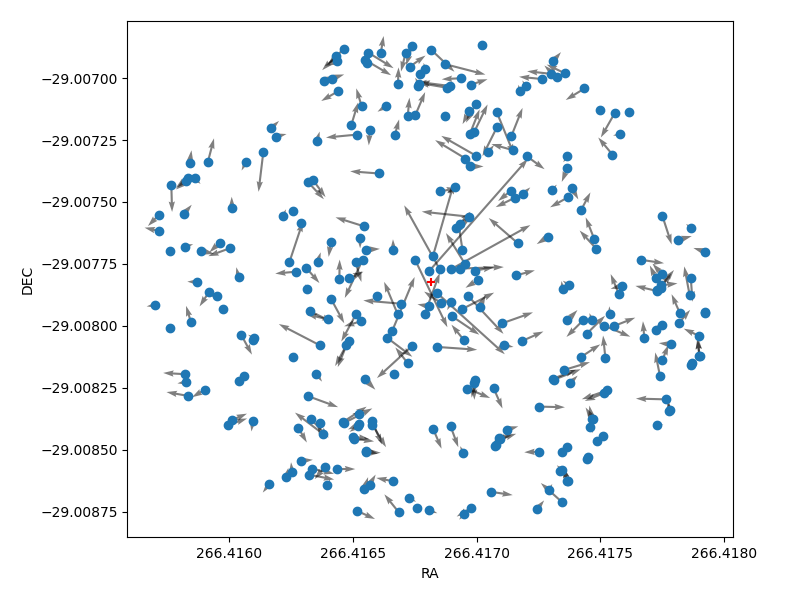A python package for astronomical calculations
Project description
Author: Behrouz Safari
License: MIT
hypatie
A python package for astronomical calculations
Installation
Install the latest version of hypatie from PyPI:
pip install hypatie
Requirements are numpy, pandas and matplotlib.
Quick start
Let's get the positions of the sun between two times:
import hypatie as hp
t1 = '2021-03-20 08:00:00'
t2 = '2021-03-20 10:00:00'
If you want the apparent RA and DEC of the Sun with respect to Earth's center (geocentric):
obs = hp.Observer('sun', t1, t2, step=5)
Now you can access the time intervals with .time attribute:
print(obs.time)
[datetime.datetime(2021, 3, 20, 8, 0)
datetime.datetime(2021, 3, 20, 8, 24)
datetime.datetime(2021, 3, 20, 8, 48)
datetime.datetime(2021, 3, 20, 9, 12)
datetime.datetime(2021, 3, 20, 9, 36)
datetime.datetime(2021, 3, 20, 10, 0)]
To acces the position you can use obs.pos, obs.ra, or obs.dec:
print(obs.pos)
[[ 3.59938235e+02 -2.66803120e-02]
[ 3.59953431e+02 -2.00920520e-02]
[ 3.59968627e+02 -1.35038600e-02]
[ 3.59983823e+02 -6.91573600e-03]
[ 3.59999018e+02 -3.27680000e-04]
[ 1.42132560e-02 6.26030600e-03]]
The first column in the above array is RA and the second column is DEC.
It is possible to get the apparent RA & DEC of a targer with respect to a specified location on the surface of a body. For example, if you want to get the apparent RA & DEC of the Sun for the Eiffel Tower :
obs = hp.Observer('sun', t1, t2, step=5, center='2.2945,48.8584,300@399')
Note that 2.2945 is the longtitude, 48.8584 is the latitude and 300 (meters) is the elevation of the Eiffel Tower. We have specified '@399' at the end which means that this coordinates is situated on the Earth (399 is the Earth's code).
You can request the cartesian positions (x,y,z) of a target with Vector class.
vec = hp.Vector('sun', t1, t2, step=5)
As with the Observer class, there are two attributes .time and .pos for Vector class. Note that when creating a Vector class, you have .x, .y and .z attributes instead of .ra and .dec.
For both Vector and Observer classes you can pass a single time to get position/state of a body at a single time:
vec = hp.Vector('sun', t1)
Both Vector and Observer classes have .plot() method.
# plot polar coordinates
obs.plot()
# plot cartesian coordinates
vec.plot()
Example: animating James Webb Space Telescope
In addition to .plot() method of Vector and Observer classes, there's a play() function that you can pass it a list of Vector objects as well as some other lists as shown in the example below:
import hypatie as hp
import matplotlib.pyplot as plt
t1 = '2018-10-01 14:18:00'
t2 = '2024-12-31 12:18:00'
# get positions with respect to the barycenter of earth-moon
earth = hp.Vector('399', t1, t2, center='500@3', step=1000)
moon = hp.Vector('301', t1, t2, center='500@3', step=1000)
jwst = hp.Vector('-170', t1, t2, center='500@3', step=1000)
bodies = [earth, moon, jwst]
names = ['Earth', 'Moon', 'James Webb']
colors = ['b','g','r']
sizes = [20, 8, 3]
# play the animation
anim = hp.play(bodies, names, colors, sizes)
plt.show()
Deep sky
You can download data from astronomical catalogues:
cat = hp.Catalogue('gaia2')
data, meta = cat.download()
or, plot the star chart for your location:
ax = hp.star_chart(lon=2.2945, lat=48.8584)
plt.show()
or, use a virtual telescope:
target = (10.6847,41.2687) # az,alt of a point in the sky
paris = (2.2945, 48.8584) # location of observer
# get image with 3 degrees field of view
tel = hp.Telescope(target_loc=target, obs_loc=paris, fov=3)
tel.show()
Explore proper motion
Let's create a chart showing the proper motion of stars near the Sgr A* (Milky Way's central supermassive black hole). The coordinates of the black hole are given and shown with the red '+' in the chart.
from hypatie.plots import explore_pm
import matplotlib.pyplot as plt
ra = 266.41681662499997
dec = -29.00782497222222
df, fig, ax = explore_pm(ra, dec, r=0.001, otype='star')
plt.show()
See more examples at astrodatascience.net
Project details
Release history Release notifications | RSS feed
Download files
Download the file for your platform. If you're not sure which to choose, learn more about installing packages.
Source Distribution
Built Distribution
File details
Details for the file hypatie-2.9.4.tar.gz.
File metadata
- Download URL: hypatie-2.9.4.tar.gz
- Upload date:
- Size: 54.2 kB
- Tags: Source
- Uploaded using Trusted Publishing? No
- Uploaded via: twine/3.7.1 importlib_metadata/4.6.1 pkginfo/1.8.2 requests/2.22.0 requests-toolbelt/0.9.1 tqdm/4.61.2 CPython/3.8.10
File hashes
| Algorithm | Hash digest | |
|---|---|---|
| SHA256 | b9ddae6e3f00c14398fe93bf400b9e1bdaabc58810f04ff9782423f4e77f9c8d |
|
| MD5 | 40a7c0a5b92cf82e5c7a5e7c31c08593 |
|
| BLAKE2b-256 | 17f8e618b786514382b17e34d7ff48b80f13ace8d0e8309f42053b08de616edf |
File details
Details for the file hypatie-2.9.4-py3-none-any.whl.
File metadata
- Download URL: hypatie-2.9.4-py3-none-any.whl
- Upload date:
- Size: 54.2 kB
- Tags: Python 3
- Uploaded using Trusted Publishing? No
- Uploaded via: twine/3.7.1 importlib_metadata/4.6.1 pkginfo/1.8.2 requests/2.22.0 requests-toolbelt/0.9.1 tqdm/4.61.2 CPython/3.8.10
File hashes
| Algorithm | Hash digest | |
|---|---|---|
| SHA256 | 3004c252850072855df925e24e1fa2ecfb215d2c02073999f0f88ee32bd1f7e7 |
|
| MD5 | 65538b2205da5664fef4ee19cea26a14 |
|
| BLAKE2b-256 | 4a1d8c0d52db54e3f7f844459511b822f6d3a60003a2cf55db7f30ebe48f5ca3 |












